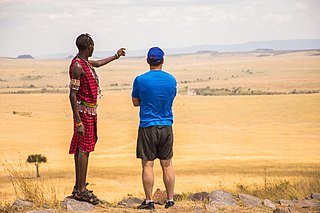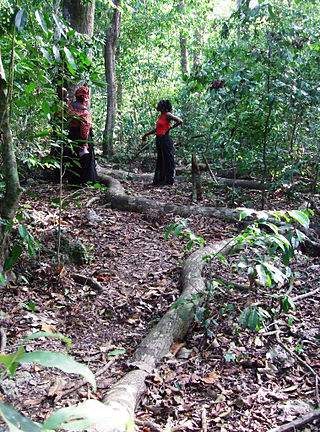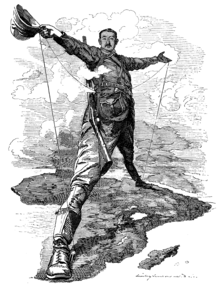
Ecotourism is a form of tourism marketed as "responsible" travel to natural areas, conserving the environment, and improving the well-being of the local people. The stated purpose may be to educate the traveler, to provide funds for ecological conservation, to directly benefit the economic development and political empowerment of local communities, or to foster respect for different cultures and human rights.

A tourist attraction is a place of interest that tourists visit, typically for its inherent or an exhibited natural or cultural value, historical significance, natural or built beauty, offering leisure and amusement.

Quintana Roo, officially the Free and Sovereign State of Quintana Roo, is one of the 31 states which, with Mexico City, constitute the 32 federal entities of Mexico. It is divided into 11 municipalities, and its capital city is Chetumal.

The Maya are an ethnolinguistic group of indigenous peoples of Mesoamerica. The ancient Maya civilization was formed by members of this group, and today's Maya are generally descended from people who lived within that historical region. Today they inhabit southern Mexico, Guatemala, Belize, El Salvador, Nicaragua, and Honduras. "Maya" is a modern collective term for the peoples of the region; however, the term was not historically used by the indigenous populations themselves. There was no common sense of identity or political unity among the distinct populations, societies and ethnic groups because they each had their own particular traditions, cultures and historical identity.

The Council for the Development of French in Louisiana is Louisiana's Office of Francophone Affairs. It is a state agency whose multiple legislative mandates include developing opportunities to use the French language in tourism, economic development, culture, education and international relations. CODOFIL is governed by a board of 23 members and administratively placed within the Louisiana Office of Cultural Development's Department of Culture, Recreation and Tourism, overseen by the Lieutenant Governor. CODOFIL is the only state agency in the United States whose purpose is to serve a linguistic population.

The Kalenjin are a group of tribes indigenous to East Africa, residing mainly in what was formerly the Rift Valley Province in Kenya and the Eastern slopes of Mount Elgon in Uganda. They number 6,358,113 individuals per the Kenyan 2019 census and an estimated 273,839 in Uganda according to the 2014 census mainly in Kapchorwa, Kween and Bukwo districts.
Commodification in a capitalist system is the action and process of transforming goods, services, ideas, nature, personal information, people or animals into commodities. A commodity is a material good such as a barrel of oil, or a bushel of wheat, that has an economic value no matter who produces it. Concepts that have been argued as being commodified include broad items such as the body, intimacy, public goods, animals and holidays.

Tourism in Mexico is a very important industry. Since the 1960s, it has been heavily promoted by the Mexican government as "an industry without smokestacks". Mexico has traditionally been among the most visited countries in the world according to the World Tourism Organization, and it is the second-most visited country in the Americas, after the United States. In 2017, Mexico was ranked as the sixth-most visited country in the world for tourism activities. Mexico has a significant number of UNESCO World Heritage Sites, with the list including ancient ruins, colonial cities, and natural reserves, as well as a number of works of modern public and private architecture. Mexico has attracted foreign visitors beginning in the early nineteenth century, with its cultural festivals, colonial cities, nature reserves and the beach resorts. The nation's temperate climate and unique culture – a fusion of the European and the Mesoamerican – are attractive to tourists. The peak tourism seasons in the country are during December and the mid-Summer, with brief surges during the week before Easter and Spring break, when many of the beach resort sites become popular destinations for college students from the United States.

Cultural heritage tourism is a form of non-business travel whereby tourists engage with the heritage, tangible and intangible, moveable and immovable, of a region through activities, experiences, and purchases which facilitate a connection to the people, objects, and places of the past associated with the locations being visited. As opposed to natural heritage tourism, which focuses on visitors' interaction with the unimproved environment of the area being visited, including outdoor sports and recreation, hiking, diving, fishing, and naturalism, and pleasure tourism without any heritage interest, such as indoor recreation, gastronomy, and hospitality without any significant precedent in the history and heritage of the region, cultural heritage tourism can include activities such as tours of immovable cultural sites, such as historic house museums, historic fortifications, human history museums, and library documentary heritage collections, opportunities for purchases of moveable cultural property, such as antiques, antiquarian books, and other works and ephemera associated with the locations being visited, and opportunities for admission to or purchase of intangible heritage experiences associated with the tourism region, including gastronomic heritage and admissions to performances such as theatre, opera, ballet, indigenous dances, and storytelling.

Sustainable tourism is a concept that covers the complete tourism experience, including concern for economic, social and environmental issues as well as attention to improving tourists' experiences and addressing the needs of host communities. Sustainable tourism should embrace concerns for environmental protection, social equity, and the quality of life, cultural diversity, and a dynamic, viable economy delivering jobs and prosperity for all. It has its roots in sustainable development and there can be some confusion as to what "sustainable tourism" means. There is now broad consensus that tourism should be sustainable. In fact, all forms of tourism have the potential to be sustainable if planned, developed and managed properly. Tourist development organizations are promoting sustainable tourism practices in order to mitigate negative effects caused by the growing impact of tourism, for example its environmental impacts.
Kilgoris is a town in Narok County, Kenya. The town has a population of 70,475. Kilgoris is one of two major urban centres in Narok County, the other being Narok town.
Identity tourism may refer to the act of assuming a racial, ethnic, socioeconomic, sexual or gender identity for recreational purposes, or the construction of cultural identities and re-examination of one's ethnic and cultural heritage from what tourism offers its patrons.
Rural tourism is a tourism that focuses on actively participating in a rural lifestyle. It can be a variant of ecotourism. Many villages can facilitate tourism because many villagers are hospitable and eager to welcome or host visitors. Agriculture has become more mechanized and requires less manual labor. This trend is causing economic pressure on some villages, which in turn causes young people to move to urban areas. There is however, a segment of the urban population that is interested in visiting the rural areas and understanding the lifestyle.

Tourism in Kenya is Kenya's third largest source of foreign exchange revenue, following diaspora remittances and agriculture. The Kenya Tourism Board is responsible for maintaining information about tourism in Kenya.

Cinque Terre National Park is a protected area inducted as an Italian national park in 1999. Located in the province of La Spezia, Liguria, northern Italy, it is the smallest national park in Italy at 4,300 acres, but also the densest with 5,000 permanent inhabitants among the five towns. In addition to the territory of the towns of Cinque Terre, the Cinque Terre National Park encompasses parts of the communes of Levanto and La Spezia. Cinque Terre was included as a UNESCO World Heritage Site in 1999.

Incidents of Travel in Chichén Itzá is an ethnographic film . Jeff Himpele and Quetzil E. Castañeda, filmmakers and producers. Production 1995 and 1997. Postproduction release: 1997.

A kaya is a sacred site of the Mijikenda people in the former Coast Province of Kenya. Often located within sacred forests, a kaya is considered to be an intrinsic source of ritual power and the origin of cultural identity; it is also a place of prayer for members of the Mijikenda ethnic group. The settlement, ritual centre, and fortified enclosure associated with the forest are also part of the kaya. In the present day, the kaya is also referred to as a traditional organizational unit of the Mijikenda. Eleven of the approximately 60 separate makaya have been grouped together and inscribed as the Sacred Mijikenda Kaya Forests, a UNESCO World Heritage Site.
Tourism impacts tourist destinations in both positive and negative ways, encompassing economic, political, socio-cultural, environmental, and psychological dimensions. The economic effects of tourism encompass improved tax revenue, personal income growth, enhanced living standards, and the creation of additional employment opportunities. Sociocultural impacts are associated with interactions between people with differing cultural backgrounds, attitudes and behaviors, and relationships to material goods. Tourism can also have significant political impacts by influencing government policies and promoting diplomatic relations between countries. Environmental impacts can be categorized as direct effects including environmental damage, wildlife destruction, deforestation, water pollution, and indirect effects, such as increased harvesting of natural resources to supply food, indirect air and water pollution. Tourism also has positive and negative health outcomes for local people. The short-term negative impacts of tourism on residents' health are related to the density of tourist's arrivals, the risk of disease transmission, road accidents, higher crime levels, as well as traffic congestion, crowding, and other stressful factors. In addition, residents can experience anxiety and depression related to their risk perceptions about mortality rates, food insecurity, contact with infected tourists, etc., which can result in negative mental health outcomes. At the same time, there are positive long-term impacts of tourism on residents' health and well-being outcomes through improving healthcare access positive emotions, novelty, and social interactions.

Ecotourism in Mexico is tourism that sustainably experiences fragile, pristine and relatively undisturbed natural areas. Tourism is a large sources of revenue for Mexico Ecotourism has received mixed responses, but organizations such as the Organization for Economic Co-Operation and Development (OECD) stressed its importance in the long-term economic health of Mexico.
Tourism has been an ever-growing industry in the Kodagu district of India. The impacts of tourism in Kodagu district effect the country's economy, environment, and culture. The impacts can be positive and negative. Ecotourism and homestays have been adopted to provide stable household income, and promote environmental awareness and cultural experiences to foreign travellers. Economic impacts include overall income increasing from employment but jobs were usually seasonal. Environmental impacts like funding from tourism would support conservation efforts and natural resource management but would bring pollution and biodiversity degradation to the district. Sociocultural impacts where residents of Kodagu like having tourists but risk losing access to resources. Kodagu district is commonly known as the "Scotland of India". The district is a hotspot for tourism and recreational activities. The mountainous Kodagu region is filled with biologically diverse tourist attractions such as waterfalls, forests, and wildlife which can be impacted by tourism.
















